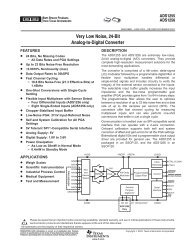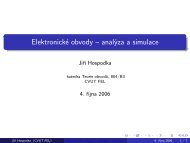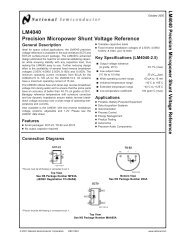<strong>LTC<strong>24</strong>10</strong>APPLICATIO S I FORSerial Clock <strong>Input</strong>/Output (SCK)ATIOU W U UThe serial clock signal present on SCK (Pin 13) is used tosynchronize the data transfer. Each bit of data is shifted outthe SDO pin on the falling edge of the serial clock.In the Internal SCK mode of operation, the SCK pin is anoutput <strong>and</strong> the <strong>LTC<strong>24</strong>10</strong> creates its own serial clock bydividing the internal conversion clock by 8. In the ExternalSCK mode of operation, the SCK pin is used as input. Theinternal or external SCK mode is selected on power-up <strong>and</strong>then reselected every time a HIGH-to-LOW transition isdetected at the CS pin. If SCK is HIGH or floating at powerupor during this transition, the converter enters the internalSCK mode. If SCK is LOW at power-up or during thistransition, the converter enters the external SCK mode.Serial Data Output (SDO)The serial data output pin, SDO (Pin 12), provides theresult of the last conversion as a serial bit stream (MSBfirst) during the data output state. In addition, the SDO pinis used as an end of conversion indicator during theconversion <strong>and</strong> sleep states.When CS (Pin 11) is HIGH, the SDO driver is switched toa high impedance state. This allows sharing the serialinterface <strong>with</strong> other devices. If CS is LOW during theconvert or sleep state, SDO will output EOC. If CS is LOWduring the conversion phase, the EOC bit appears HIGH onthe SDO pin. Once the conversion is complete, EOC goesLOW. The device remains in the sleep state until the firstrising edge of SCK occurs while CS = LOW.Chip Select <strong>Input</strong> (CS)The active LOW chip select, CS (Pin 11), is used to test theconversion status <strong>and</strong> to enable the data output transfer asdescribed in the previous sections.In addition, the CS signal can be used to trigger a newconversion cycle before the entire serial data transfer hasbeen completed. The <strong>LTC<strong>24</strong>10</strong> will abort any serial datatransfer in progress <strong>and</strong> start a new conversion cycleanytime a LOW-to-HIGH transition is detected at the CSpin after the converter has entered the data output state(i.e., after the first rising edge of SCK occurs <strong>with</strong>CS␣=␣LOW).Finally, CS can be used to control the free-running modesof operation, see Serial Interface Timing Modes section.Grounding CS will force the <strong>ADC</strong> to continuously convertat the maximum output rate selected by F O . Tying acapacitor to CS will reduce the output rate <strong>and</strong> powerdissipation by a factor proportional to the capacitor’svalue, see Figures 12 to 14.SERIAL INTERFACE TIMING MODESThe <strong>LTC<strong>24</strong>10</strong>’s 3-wire interface is SPI <strong>and</strong> MICROWIREcompatible. This interface offers several flexible modes ofoperation. These include internal/external serial clock,2- or 3-wire I/O, single cycle conversion <strong>and</strong> autostart. Thefollowing sections describe each of these serial interfacetiming modes in detail. In all these cases, the convertercan use the internal oscillator (F O = LOW or F O = HIGH) oran external oscillator connected to the F O pin. Refer toTable␣ 4 for a summary.External Serial Clock, Single Cycle Operation(SPI/MICROWIRE Compatible)This timing mode uses an external serial clock to shift outthe conversion result <strong>and</strong> a CS signal to monitor <strong>and</strong>control the state of the conversion cycle, see Figure 5.Table 4. <strong>LTC<strong>24</strong>10</strong> Interface Timing ModesConversion Data ConnectionSCK Cycle Output <strong>and</strong>Configuration Source Control Control WaveformsExternal SCK, Single Cycle Conversion External CS <strong>and</strong> SCK CS <strong>and</strong> SCK Figures 5, 6External SCK, 2-Wire I/O External SCK SCK Figure 7Internal SCK, Single Cycle Conversion Internal CS ↓ CS ↓ Figures 8, 9Internal SCK, 2-Wire I/O, Continuous Conversion Internal Continuous Internal Figure 10Internal SCK, Autostart Conversion Internal C EXT Internal Figure 1116
<strong>LTC<strong>24</strong>10</strong>APPLICATIO S I FORATIOU W U UThe serial clock mode is selected on the falling edge of CS.To select the external serial clock mode, the serial clock pin(SCK) must be LOW during each CS falling edge.The serial data output pin (SDO) is Hi-Z as long as CS isHIGH. At any time during the conversion cycle, CS may bepulled LOW in order to monitor the state of the converter.While CS is pulled LOW, EOC is output to the SDO pin.EOC␣ =␣ 1 while a conversion is in progress <strong>and</strong> EOC = 0 ifthe device is in the sleep state. Independent of CS, thedevice automatically enters the low power sleep state oncethe conversion is complete.When the device is in the sleep state (EOC = 0), itsconversion result is held in an internal static shift register.The device remains in the sleep state until the firstrising edge of SCK is seen while CS is LOW. Data is shiftedout the SDO pin on each falling edge of SCK. This enablesexternal circuitry to latch the output on the rising edge ofSCK. EOC can be latched on the first rising edge of SCK<strong>and</strong> the last bit of the conversion result can be latched onthe 32nd rising edge of SCK. On the 32nd falling edge ofSCK, the device begins a new conversion. SDO goes HIGH(EOC = 1) indicating a conversion is in progress.At the conclusion of the data cycle, CS may remain LOW<strong>and</strong> EOC monitored as an end-of-conversion interrupt.Alternatively, CS may be driven HIGH setting SDO to Hi-Z.As described above, CS may be pulled LOW at any time inorder to monitor the conversion status.Typically, CS remains LOW during the data output state.However, the data output state may be aborted by pullingCS HIGH anytime between the first rising edge <strong>and</strong> the32nd falling edge of SCK, see Figure 6. On the rising edgeof CS, the device aborts the data output state <strong>and</strong> immediatelyinitiates a new conversion. This is useful for systemsnot requiring all 32 bits of output data, aborting aninvalid conversion cycle or synchronizing the start of aconversion.External Serial Clock, 2-Wire I/OThis timing mode utilizes a 2-wire serial I/O interface. Theconversion result is shifted out of the device by an externallygenerated serial clock (SCK) signal, see Figure 7. CSmay be permanently tied to ground, simplifying the userinterface or isolation barrier.The external serial clock mode is selected at the end of thepower-on reset (POR) cycle. The POR cycle is concludedapproximately 0.5ms after V CC exceeds 2.2V. The levelapplied to SCK at this time determines if SCK is internal orexternal. SCK must be driven LOW prior to the end of PORin order to enter the external serial clock timing mode.REFERENCEVOLTAGE0.1V TO V CCANALOG INPUT RANGE–0.5V REF TO 0.5V REF2.7V TO 5.5V1µF2V CC F O14<strong>LTC<strong>24</strong>10</strong>3REF + 13SCK4REF –561, 7, 8, 9, 10, 15, 16IN +IN –GNDSDO12CS11V CC= 50Hz REJECTION= EXTERNAL OSCILLATOR= 60Hz REJECTION3-WIRESPI INTERFACECSTEST EOCTEST EOCBIT 31BIT 30BIT 29BIT 28BIT 27 BIT 26BIT 5BIT 0TEST EOCSDOHi-ZHi-ZEOCSIGMSBLSBSUB LSBHi-ZSCK(EXTERNAL)CONVERSIONSLEEP DATA OUTPUT CONVERSION<strong>24</strong>10 F05Figure 5. External Serial Clock, Single Cycle Operation17






